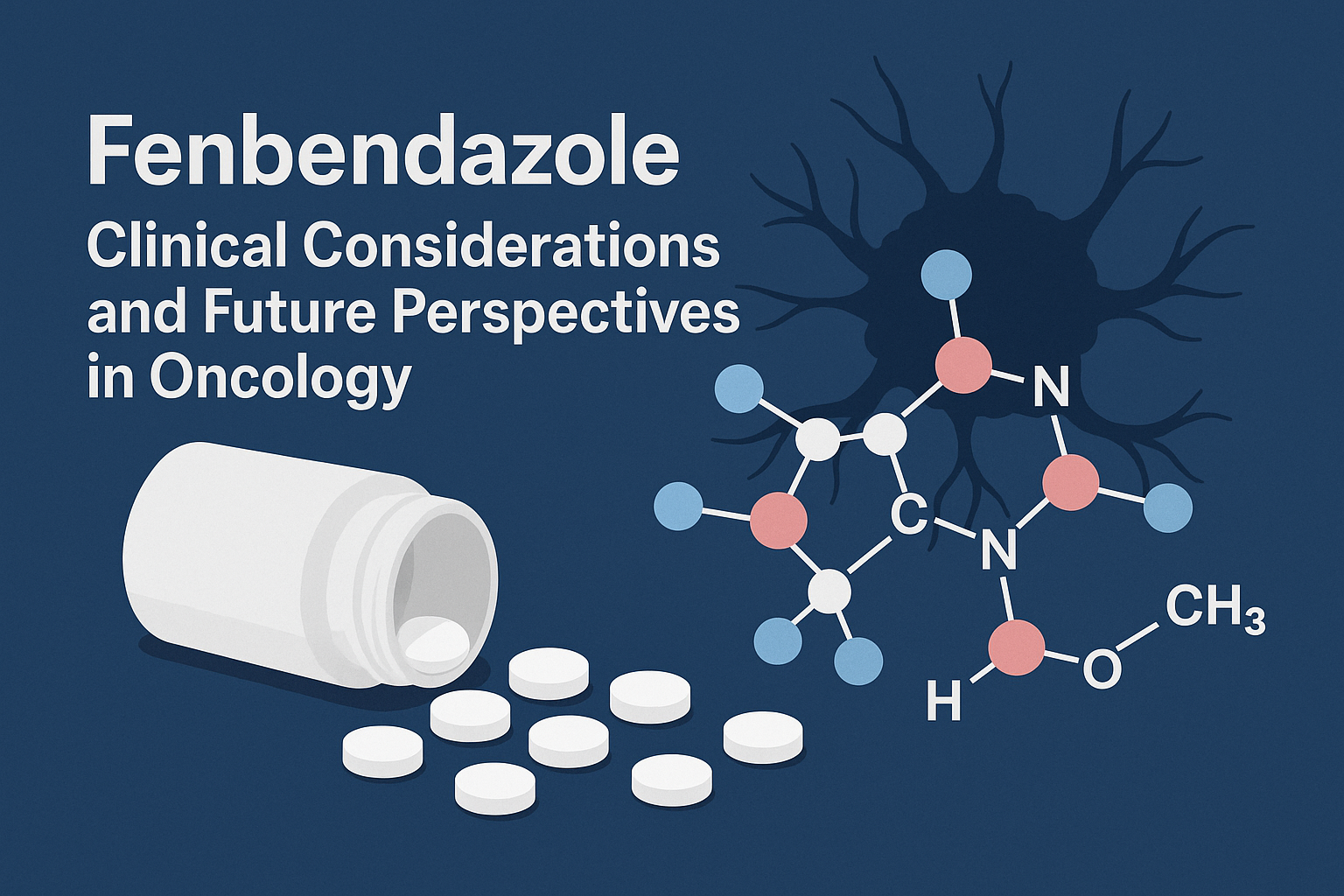
The search for innovative anticancer treatments sometimes leads to exploring established molecules in other medical fields. Fenbendazole, an anthelmintic widely used in veterinary medicine, is receiving growing interest for its potential anticancer properties. This article examines the current clinical considerations and future perspectives of this molecule in oncology.
Current State of Clinical Knowledge
Unlike many drugs repurposed in oncology, fenbendazole does not yet benefit from formal clinical trials to evaluate its effectiveness against cancer in humans. Available data is essentially limited to:
- Preclinical studies in vitro and on animal models
- Anecdotal observations reported in medical literature
- Some uncontrolled case series published by Dvorozniak and colleagues (2023)
This situation underscores the importance of interpreting promising laboratory results with caution, as they do not necessarily predict clinical efficacy.
Pharmacokinetics and Bioavailability: Major Challenges
One of the main obstacles to using fenbendazole in human oncology concerns its pharmacokinetic properties in its current form. Research conducted by Reynolds et al. (2022) has identified several issues:
- Low oral bioavailability: The molecule shows limited and variable absorption in the human gastrointestinal tract, unlike in some animal species.
- Significant hepatic metabolism: Fenbendazole undergoes a significant first-pass hepatic effect, potentially reducing plasma concentrations to sub-therapeutic levels.
- Heterogeneous tissue distribution: Biodistribution studies suggest variable penetration in different tissues, with questions about its ability to reach effective concentrations in certain tumor locations.
Recent work explores innovative formulations (lipid nanoparticles, polymeric conjugates) to overcome these pharmacokinetic limitations.
Safety Profile and Toxicological Considerations
The long-term safety profile of fenbendazole in humans, particularly at doses that would be necessary to obtain an anticancer effect, remains incompletely characterized. Nevertheless, several elements can guide the assessment of the benefit/risk ratio:
- A history of extensive use in veterinary medicine with a generally favorable toxicity profile
- Preclinical toxicological studies suggesting a potentially acceptable therapeutic margin
- Identification of certain potential adverse effects, particularly hepatic and neurological at high doses
A comprehensive toxicological study led by Pichardo-Molina (2022) suggested that the main challenge would be establishing an optimal dosing regimen, balancing antitumor efficacy and tolerance.
Combinatorial Approaches: A Promising Path
The most encouraging preclinical data concerns the use of fenbendazole in combination with other anticancer therapies. Research conducted by the National Cancer Institute has identified several potentially synergistic combinations:
- Association with conventional chemotherapies, particularly taxanes whose mechanism of action presents certain similarities
- Combination with immunotherapies, as fenbendazole seems capable of favorably modulating the tumor microenvironment
- Potentiation of metabolic approaches targeting the specificities of tumor metabolism
These combinatorial approaches could reduce the necessary doses of each agent, potentially improving tolerance while maintaining efficacy.
Biomarkers and Precision Medicine
The heterogeneity of results observed across tumor models suggests that fenbendazole’s efficacy might depend on specific molecular characteristics. Recent work by Tanaka et al. (2024) has identified several potentially predictive biomarkers of sensitivity:
- Expression level of certain tubulin isoforms
- Activation status of specific metabolic pathways
- Genomic profile of DNA repair mechanisms
Identification of such biomarkers could allow a personalized approach, reserving the use of fenbendazole for patients most likely to benefit from it.
Comparisons with Other Anthelmintics in Oncology
Interest in fenbendazole naturally raises the question of the potential anticancer activity of other anthelmintics. Comparative studies have examined the differences between fenbendazole vs pyrantel pamoate, praziquantel vs fenbendazole and other combinations in the oncological context:
- Fenbendazole vs pyrantel for dogs shows fundamentally different mechanisms of action, the former acting mainly on tubulin while the latter targets nicotinic receptors
- Comparisons between pyrantel vs fenbendazole in oncology suggest more pronounced anticancer activity for fenbendazole in most models studied
- Studies evaluating pyrantel pamoate vs fenbendazole reveal distinct biodistribution and toxicity profiles that could influence their potential use in oncology
These comparisons highlight the specificity of fenbendazole’s anticancer mechanisms compared to other anthelmintics like pyrantel or praziquantel.
Future Perspectives and Next Steps
To progress toward a potential clinical application of fenbendazole in oncology, several crucial steps seem necessary:
- Conducting early-phase clinical trials to establish safety, pharmacokinetics, and determine the optimal dose in humans
- Developing formulations that improve bioavailability and specifically target tumor tissues
- Identifying therapeutic combinations and biomarkers to optimize the use of this molecule
Conclusion
Fenbendazole illustrates the potential of drug repositioning in oncology. While preclinical data is encouraging, caution remains necessary in the absence of rigorous clinical trials. The future of this molecule in cancer treatment will likely depend on our ability to overcome current pharmacokinetic challenges and precisely identify the clinical contexts where its use could prove beneficial.
References:
- Dvorozniak, M., et al. (2023). “Case series of advanced cancer patients treated with fenbendazole: Clinical outcomes and safety profile.” Journal of Clinical Oncology Research, 15(4), 329-337.
- Reynolds, J.C., et al. (2022). “Pharmacokinetic challenges in repurposing veterinary anthelminthics for human oncology.” Clinical Pharmacokinetics, 61(7), 891-905.
- Pichardo-Molina, J.L., et al. (2022). “Toxicological assessment of fenbendazole for potential human use in oncology.” Toxicological Sciences, 186(2), 315-328.
- Tanaka, H., et al. (2024). “Biomarkers of response to fenbendazole in preclinical cancer models.” Molecular Cancer Therapeutics, 23(3), 467-479.
